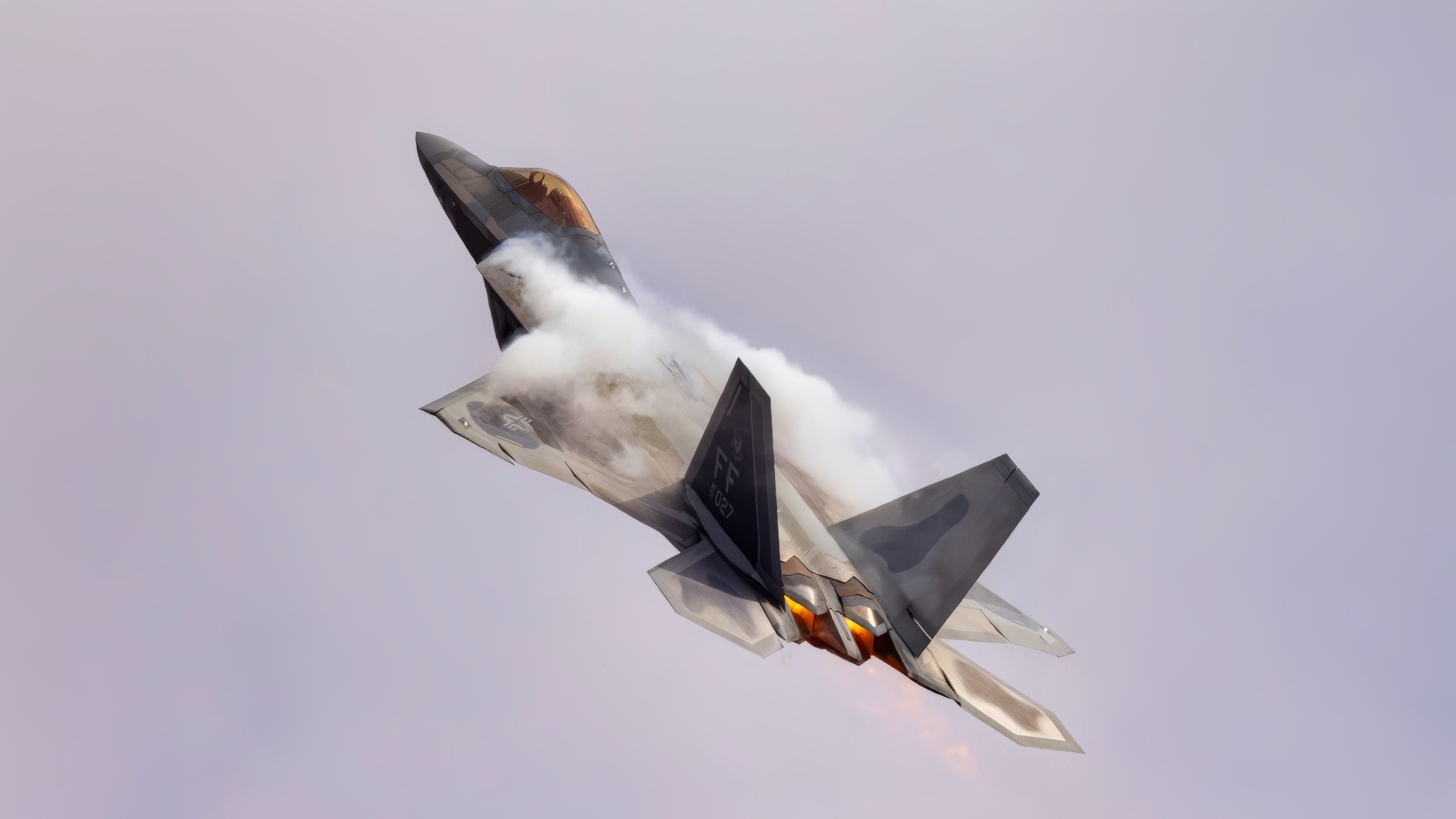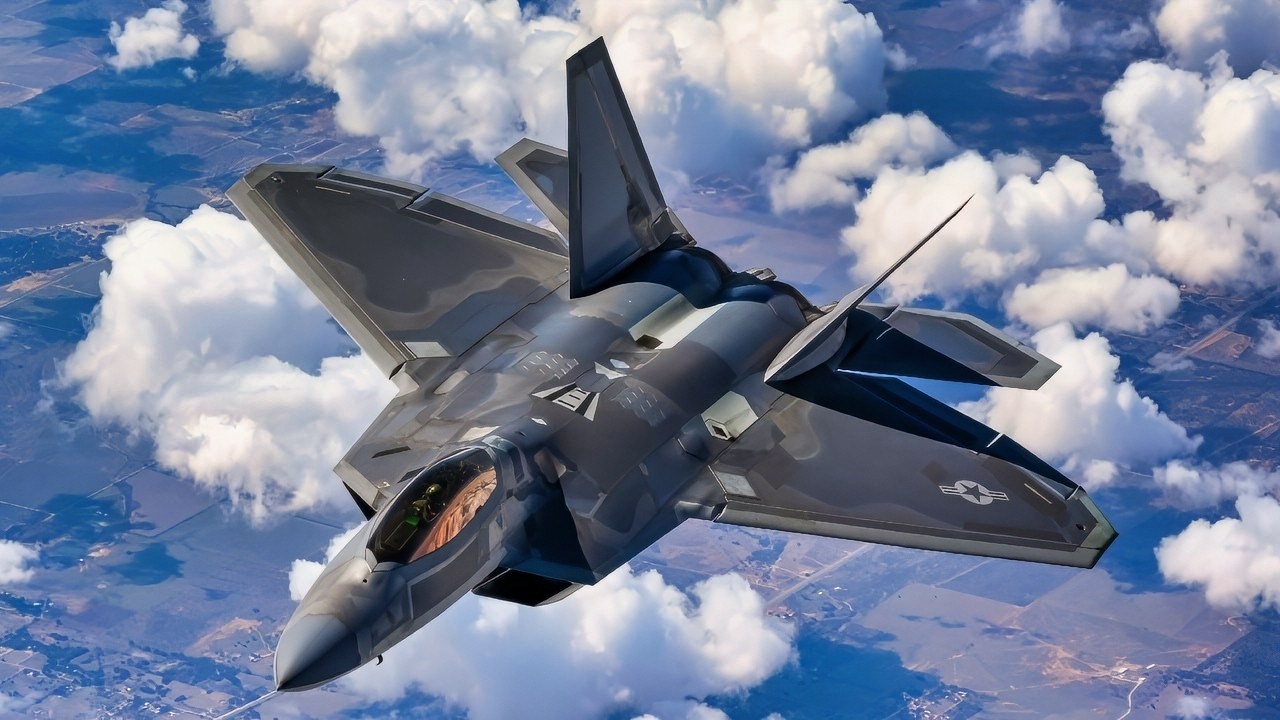Key Points and Summary – The F-22 remains the world’s stealth dogfighting gold standard, but it’s an aging champion. Clearly, the F-22 Raptor’s biggest enemy is time and age.
-High operating costs, legacy materials, short Indo-Pacific legs, and obsolete subsystems—plus a capped fleet—limit its future.
-The Air Force plans to retire non-combat Block 20s while squeezing upgrades from combat-coded jets.
-Enter NGAD’s F-47: a stealthier, longer-range sixth-gen “quarterback” designed to team with autonomous Collaborative Combat Aircraft and survive modern EW and missile threats.
-Shutting the Raptor line locked numbers; now the pivot is clear.
-The F-22 stays lethal, but the mission is moving on—and NGAD will carry America’s air-dominance banner next.
The F-22 Is Still The King, But An Aging One
Despite upgrades and the addition of Block 20 aircraft to expand the fleet, the USAF plans to retire the F-22 Raptor around 2030, primarily due to two reasons: the F-22’s high operating costs and its obsolescence in several areas, with the obsolescence being the primary factor.
Earlier this spring, President Trump confirmed that Boeing secured a contract to develop the U.S. military’s Next Generation Air Dominance (NGAD) program, a project valued at over $20 billion.
The NGAD sixth-generation stealth fighter is expected to replace the F-22 Raptor. Trump confirmed the long-held rumors that the NGAD stealth fighter has been flying for the past five years. The new F-47, as it has been named, is slated to replace the F-22 within the next decade.
“The F-47 will be the most advanced, most capable, most lethal aircraft ever built,” Trump told reporters. “America’s enemies will never see it coming,” he added.
The new aircraft will feature state-of-the-art stealth capabilities, engines capable of powering them past Mach 2, and the ability to operate as a quarterback for stealth drone fighters, thereby maintaining American air dominance.
The F-22 Is Very Expensive To Fly And Maintain
With its high operating costs, the F-22 fleet was capped at 186 at the end of the Cold War, resulting in small quantities to replace the F-15. Consequently, its logistics and supply chain do not benefit from economies of scale as much as jets like the F-16 and F-35.
The F-22 also utilizes older stealth materials, which increase maintenance costs. Properly retrofitting the F-22 with the F-35’s more durable complete material stack is also not possible without replacing the composite panels of every F-22.
These composites are not the same, so the structural strength of the jet and possibly the thickness of its skin would be affected, requiring recertification of its life limit and likely some redesigns of panels and doors to accommodate altered geometry.
Several other technological advances enable fighters to be cheaper to maintain, but these require redesigns of the F-22, some of which are extensive.
The F-22’s Range Is Too Limited For an Indo-Pacific War
Aviation analyst James Smith wrote on Quora that the F-22 was designed for a different war.
“The F-22 was designed primarily for fighting in Europe and turn of the millennium era threats, and so its combat radius of approximately 590 nautical miles (less with any use of supercruise) is not ideal for a war with China.
“This is because jets may need to be flying from locations like Guam and relying on tankers only ~400 nautical miles (if F-22s are using supercruise) behind the F-22s, which would then be threatened by new very long range missiles and enemy stealth fighters that may be able to slip sufficiently far past fighter screens to take those tankers out.

F-22 Raptor Firing Missile. Image Credit: Creative Commons.

The U.S. Air Force F-22 Raptor Demonstration Team performs during the 2025 Marine Corps Air Station Miramar Air Show in San Diego, Sept. 27, 2025. The F-22 Raptor Demonstration Team performs precision aerial maneuvers at Air Shows across the world to demonstrate the unique capabilities of the world’s premier 5th generation fighter aircraft. America’s Air Show 2025 is a unique and incredible opportunity to witness Marine and joint aviation capabilities, civilian performers and the world-famous Blue Angels; to celebrate the 250th birthday of the Marine Corps alongside Marines and to see first-hand the innovative spirit of the Marine Corps through emerging technologies and forward-thinking. (U.S. Marine Corps photo by Lance Cpl. Jordan Searls)
“By comparison, the F-35A (land-based variant) has an air-to-air combat radius of 760 nautical miles, with a new engine being developed for it which would boost that to nearly 1000 nautical miles. The F-22’s NGAD successor is also anticipated to have an approximately 1000+ nautical miles combat radius.”
Aging Technology
Some subsystems are becoming obsolete, particularly the Common Integrated Processor (CIP) and Intra-Flight Data Link (IFDL), which struggle in high-intensity electronic warfare.
The F-22 Block 20 that the Air Force plans to use refers to the 32 older, non-combat-configured versions of the F-22 Raptor that the U.S. Air Force has been attempting to retire, but Congress has repeatedly blocked.
These aircraft are used for training purposes but lack modern communications, electronic warfare systems, and the ability to fire modern weapons, unlike the combat-ready Block 30 and 35 versions.
The debate continues over whether to retire them to fund next-generation aircraft or to upgrade them to increase the total number of combat-capable Raptors.
The F-47 Is Stealthier Than The Raptor:
The F-22 Raptor is the world’s oldest stealth fighter; it was designed in the 1990s and has been in service for over 20 years. Despite this, it remains the stealthiest fighter, bar none, with a radar cross-section that’s generally estimated to be as much as 15 times smaller than the F-35 and maybe 100 times smaller than China’s J-20.
The F-22 remains the standard by which every other stealth fighter is measured. Even after 20 years of service, it is still the best stealth fighter in the world. But the rest of the world is slowly catching up. And it’s time, as #1 will soon end and be replaced by the F-47.
Why Does The Raptor Need to Be Replaced?
It is time. The airframes, although still having plenty of life left, have accumulated a significant number of hours. More than anything, the Raptor was just a victim of bad timing. The USAF had this incredible fighter, but with the Soviet Union having collapsed, there was no one left to fight. The US was spending trillions of dollars fighting two wars in Iraq and Afghanistan, and budget cuts were looming.
Then, the US made a big mistake. It didn’t pause the F-22 production line—it shut it down. Yes, the F-22 was costly, but if they had kept producing them, the cost would have been reduced. But the assembly line was shut down.
Only 186 Raptors were produced, and currently, there are between 150 and 180 combat-capable aircraft. The US has been pouring money into upgrades to keep it atop the heap, but that 180 number is a hard stop. If an airplane suffers an accident or is lost in combat, it can not be replaced.
The high cost of maintenance and operation is prohibitive. The Chinese have produced hundreds of J-20s. The NGAD F-47 will have a significant technological advantage over anything our enemies possess.

F-47. X Screenshot.
With a production line pushing out F-47s, the F-22 Raptors will still be around until the fleet of F-47s is manned and ready. The good thing is that with the host of new technologies for the F-47, the F-22 will benefit from some of them, as the Air Force upgrades the Raptors to keep them equipped with the best technology.
The Air Force plans to retire 32 older Block 20 F-22s that are no longer suitable for combat operations. The Block 20s were primarily designed for training purposes and are not combat-coded. The Eurasian Times reported, “Additionally, these jets belong to the early production models known as Block 20 jets, primarily designed for training purposes and are not combat-capable.”
Regarding this batch of older F-22s, LTG Richard Moore states, “They will never be a part of the combat force.” By retiring them, the Air Force could save around $500 million a year. It would cost the Air Force $3.5 billion to bring these 32 F-22s to combat capability.
The Air Force loves the F-22, but it simply doesn’t have enough of them, and with no production line to make more, it is time to transition to the F-35. The unusual aspect of the long saga of the F-22 is that it will be retired before the plane it replaced, as the F-15EX will continue to fly.

An F-15EX Eagle II from the Defense Contracting Management Agency Boeing St. Louis, sits on the flight line at Selfridge Air National Guard Base, Michigan, June 11, 2025. The aircraft visited the base as part of a site activation task force, an initial step to prepare the 127th Wing with the right infrastructure, personnel, and support the incoming F-15EX and KC-46 Pegasus missions . (U.S. Air National Guard photo by 1st Lt. Elise Wahlstrom)
It is an expensive machine. As Alex Hollings wrote, “the F-22 upgrade budget is enough to purchase 132 new F-35As and still have enough left over for a very comfortable retirement. In terms of the 150 combat-coded F-22s in America’s stable, that shakes out to roughly $72.6 million in upgrades allocated to each individual Raptor.”
In the meantime, with the F-47 and the F-35 having the capability to operate the Air Force’s Collaborative Combat Aircraft (CCA) program, which is a multi-pronged initiative to test, develop, and implement new autonomous and manned-unmanned aircraft teaming concepts.
It is also known as the Loyal Wingman concept, capable of flying independently or in small groups that will be used to counter China’s anti-access/area-denial (A2/AD) capabilities. The F-22 will also be able to deploy with these.
The Raptor is still the King of the dogfighters, but it is an aging platform and growing obsolescent against missiles.
About the Author: Steve Balestrieri
Steve Balestrieri is a National Security Columnist. He served as a US Army Special Forces NCO and Warrant Officer. In addition to writing on defense, he covers the NFL for PatsFans.com and is a member of the Pro Football Writers of America (PFWA). His work was regularly featured in many military publications.
More Military
Europe’s New 6th Generation GCAP Stealth Fighter Looks Unaffordable
49 ‘New’ M1A1 Abrams Tanks Were Sent to Ukraine by Australia and America Doesn’t Approve
The U.S. Marine Corps Is Facing a Tough Drone Reality
‘300 Percent More Lethal’: The U.S. Army Is Putting China and Russia on Notice










